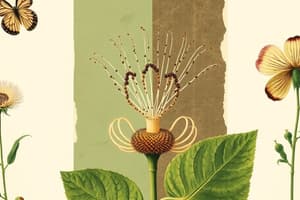Podcast
Questions and Answers
What is the primary function of fruits in angiosperms?
What is the primary function of fruits in angiosperms?
- Attracting pollinators
- Supporting the flower structure
- Protecting and dispersing seeds (correct)
- Providing nourishment for the embryo
Which part of the flower is responsible for producing pollen?
Which part of the flower is responsible for producing pollen?
- Carpels
- Petals
- Sepals
- Stamens (correct)
How do pollen and seeds contribute to the independence of vascular plants from water?
How do pollen and seeds contribute to the independence of vascular plants from water?
- They absorb water directly from the environment.
- They allow fertilization and growth without needing water.
- They enable dormancy and early development under dry conditions. (correct)
- They rely on the presence of water for the dispersion of seeds.
What distinguishes gymnosperms from angiosperms?
What distinguishes gymnosperms from angiosperms?
What is the dominant phase of the life cycle in ferns?
What is the dominant phase of the life cycle in ferns?
Which type of vascular plants includes club mosses, horsetails, and ferns?
Which type of vascular plants includes club mosses, horsetails, and ferns?
What role do petals play in flowering plants?
What role do petals play in flowering plants?
What do ovules develop into after fertilization in angiosperms?
What do ovules develop into after fertilization in angiosperms?
What is the primary function of xylem tissue in vascular plants?
What is the primary function of xylem tissue in vascular plants?
What are the female reproductive structures in mosses called?
What are the female reproductive structures in mosses called?
Which of the following accurately describes bryophytes?
Which of the following accurately describes bryophytes?
What stage comes after the fertilization of the egg in the moss life cycle?
What stage comes after the fertilization of the egg in the moss life cycle?
In mosses, the process of fertilization involves what characteristic of antherozoids?
In mosses, the process of fertilization involves what characteristic of antherozoids?
Which division of plants consists of gymnosperms and angiosperms?
Which division of plants consists of gymnosperms and angiosperms?
What are rhizoids in bryophytes primarily used for?
What are rhizoids in bryophytes primarily used for?
Which of the following is incorrectly matched with its function?
Which of the following is incorrectly matched with its function?
Study Notes
Angiosperms
- Flowers are modified leaves that facilitate reproduction.
- Seeds include an embryo with a food source, allowing dormancy and germination.
- Fruits protect seeds and assist in their dispersal, encouraging animals to relocate them.
Reproductive Structures
- Stamen is the male reproductive part, producing pollen.
- Carpel is the female reproductive part, containing ovules that develop into seeds post-fertilization.
Anatomy of Angiosperms
- Sepals protect flower buds and can assist in photosynthesis.
- Petals attract pollinators, playing a crucial role in reproduction.
- Male stamens produce pollen, which contains sperm cells and a pollen tube.
- Female carpels house egg cells within ovules, leading to seed development after fertilization.
Evolution of Seed Plants
- Pollen allows for reproduction independent of water, facilitating fertilization through wind or animals.
- Seeds contain an embryo and nourishment, enclosed in a protective coat, and can remain dormant.
- Gymnosperms are known as "naked seed" plants, non-flowering and usually cone-bearing.
Vascular Plants – Lycophytes and Pterophytes
- Seedless vascular plants include club mosses, horsetails, and ferns.
- These plants displayed dominance during the Carboniferous period, contributing to coal deposits.
- Water is essential for fertilization; thus, these plants thrive in wet environments.
- Ferns' lifecycle includes distinct sporophytes producing spores and gametophytes producing gametes.
Vascular Plant Evolution
- Vascular plants feature specialized tissues for transport, supporting greater heights.
- Xylem transports water and minerals from roots to shoots.
- Phloem distributes sugars and organic molecules from leaves to roots for storage.
- True roots and leaves enhance structural support and size; mycorrhizal fungi aid nutrient uptake.
Life Cycle of Moss
- Mosses alternate between haploid gametophyte and diploid sporophyte in their life cycle.
- Female sex organs (archegonia) produce eggs, while male organs (antheridia) release biflagellate antherozoids that swim to fertilize eggs.
- The zygote develops into a sporophyte, which produces spores to propagate new plants.
Characteristics of Bryophytes
- Bryophytes are non-vascular, seedless plants including liverworts, hornworts, and mosses, confined to moist areas.
- Lacking lignin, they rely on rhizoids, not true roots, for anchoring.
- Sperm must swim to the egg, a trait reflecting their aquatic ancestry.
Divisions of Land Plants (Embryophytes)
- Vascular plants split into seedless (lycophytes and pterophytes) and seed plants (gymnosperms and angiosperms).
- Gymnosperms bear seeds in cones without true flowers or fruits, while angiosperm seeds develop within flower ovaries and are protected by fruit.
- Nonvascular plants, or bryophytes, comprise liverworts, hornworts, and mosses.
Overview of the Plant Kingdom
- The Plant Kingdom consists of eukaryotic organisms with a lineage derived from cyanobacterium through endosymbiosis.
- Red algae, such as nori, are representative members of this lineage, illustrating early plant evolution.
Studying That Suits You
Use AI to generate personalized quizzes and flashcards to suit your learning preferences.
Description
This quiz covers the essential aspects of angiosperms, focusing on their reproductive structures such as flowers and seeds. Understand the roles of stamens and carpels, and the significance of fruits and pollinators in plant reproduction. Test your knowledge on the key elements that make angiosperms unique in the plant kingdom.





